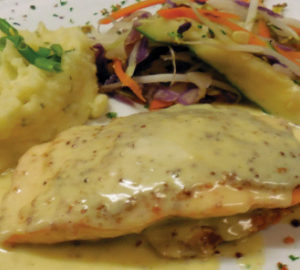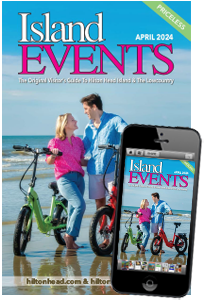We were always bored. But when the keys to the motorboat were relinquished and the May River, things changed.
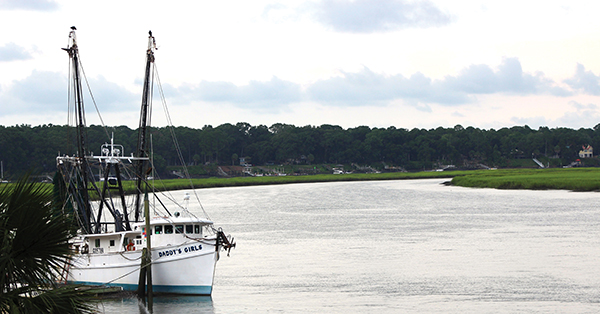
“Be careful,” Mom said as we rushed down the dock. The tube hit the water as fast as you could say, “I’m first!” and we were off. What was she thinking? The entire goal of tubing is to destroy the rider—to throw them off so that their bodies bounce across the water like a skipping stone. How in the heck did we not injure each other? Not only was it dangerous, it was the most fun I have ever had.
My second best memory? Exploring the May River. Little did I know that these expeditions would shape my career.
We didn’t have a depth sounder, GPS, cell phone, bottled water or even a current registration, but we survived somehow. When we hit a sandbar, we had to figure out a way to get the boat to float again after collecting all of the items that flew off after hitting the sand at 20 mph. Thank goodness a Boston Whaler is “unsinkable.” After hitting the sandbar a second time, we were sure to remember it. Most of my knowledge of bottom topography in the May was ingrained during these episodes.
“Do NOT take the boat out at night,” Mom said. The boat had no running lights and drifted quite nicely down the river before we cranked the engine.
Nighttime brought new and interesting things to the water’s edge.
One tool that is old school enough to be applied is the flashlight, with a bulb. LED was not available yet, but shining a somewhat dim light into the marsh grass at low tide was like plugging in Christmas lights. Of course, we were terrified and our screams scared the animals away—but they were there the next night and we were prepared to be brave. A glimpse of body shape and fur revealed that the owners of glowing eyes were raccoons, mink and river otters. Also, deer made an appearance in the background at the high marsh, closer to solid ground. That is as far as my childhood interest extended.
I didn’t wonder why the animals were there, and I’m pretty sure that they didn’t care to see children in the middle of the night shining lights in their eyes. We were interrupting their dinner of fiddler crabs and snails.
Though deer are vegetarians, they do not eat marsh grass.
It is too tough and they prefer the plants you paid money for—chewy with exotic flavor. Adults may be interested to learn that deer lick marsh grass to add a mineral to their diet that they would otherwise get from rocks: salt. (FYI, rocks are not found naturally in the Lowcountry. They have all been brought here from somewhere else.) Marsh grass is the only plant on the Eastern Seaboard that drinks salt water and excretes salt out the blade. I remember thinking that marsh grass had shiny diamonds (actually dried salt crystals) on its leaves when the summer sun was strong. But again, I did not wonder why.
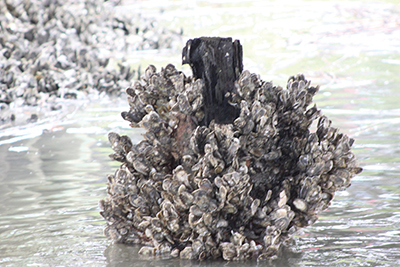
To me, it looked like an oyster grew branches to make the cluster. I will have to say that this is quite logical, but incorrect. Larval oysters attach to a hard surface when they are ready to settle down. Since there are naturally no rocks in the Lowcountry, the available hard surface is each other. Crassostrea Virginica, or Eastern oyster, are abundant on the Atlantic Coast, but look and taste different in a variety of ecosystems. Oysters in Beaufort County filter water from the nursery of the ocean, consuming millions of microorganisms floating in the water column—that is what you are tasting.
They grow long and slender because they are growing so close to one another in the cluster.
The Blue Point oyster in Connecticut is the same species, but is singular and round as there are plenty of rocks to attach to and room to spread out. Their diet is very different outside of the salt marsh estuary and, therefore, they taste different.
I also didn’t understand why my fiddler crab collection never made it past three days in a bucket with sand. In hindsight, I should have made the connection: The tide never comes inside the bucket. Without sea water to moisten their gills, the fiddler crabs dry out. Despite all of the attention that I gave them, I didn’t know to add salt water.
Another thing I didn’t quite know was the location of a blue crab’s mouth.
It is between the eyes, but isn’t it logical for a child to think the mouth is the pincer on the claw? Please say yes. I thought that the crab’s teeth were the jagged sharp edges that bit you. Then they swallowed the food at the pincer and it traveled down the claw and into the belly. Actually, the pincer delivers the food to the mouthparts, which also move back and forth to force water inward and over their gills. If I had slowed down for two seconds, I may have figured these things out more quickly.
I did think from time to time about things that made no sense.
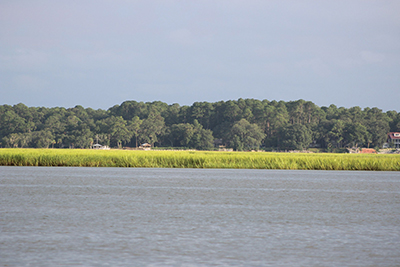
My mom told me to go wash off with the hose when I was sticky after swimming in the river. She said it was the salt drying on my back that made me uncomfortable. I HATE washing my hair—still do—but when I skipped my hair during the hose down, I thought to myself: “Salt doesn’t smell bad and water doesn’t smell bad so I’m good.
” However, something was very wrong with this theory. It was the microorganisms from the ocean’s nursery still in my hair that produced the unpleasant smell. When you get out of the water in the Lowcountry and you feel sticky, it is not only salt. Just so you know.
Looking back, I wish that I had been more patient and observant.
But then I was a teenager (enough said). Enjoy the river; it is more entertaining than you can imagine.
Written by Amber Hester Kuehn, Owner of Spartina Marine Education Charters
